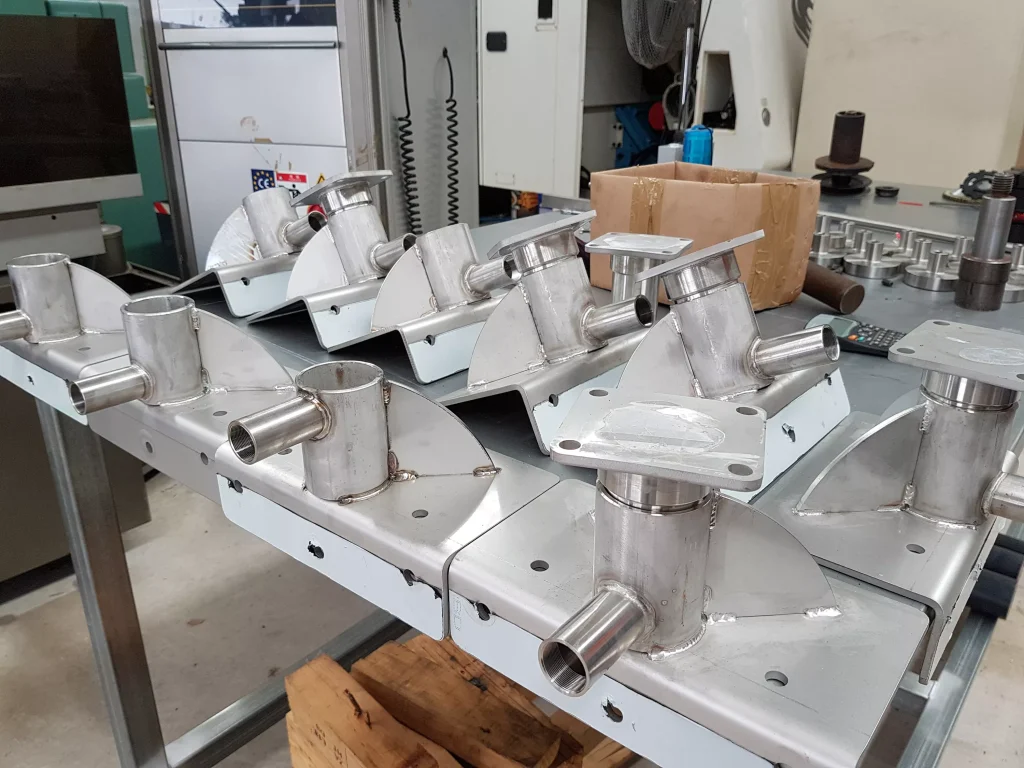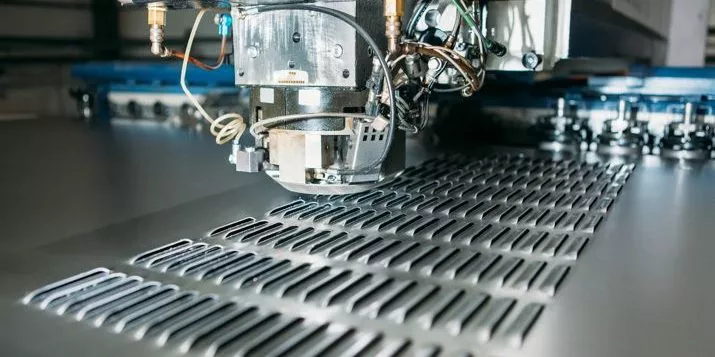Sheet metal fabrication is the process of turning sheet metal from raw materials into the required parts or structural parts of a product. The manufacturing processes involved in the fabrication of metal parts or products vary depending on the manufacturing needs and usually include: cutting, stamping, bending, welding, assembly, and surface treatment.
In a broad sense, sheet metal fabrication is manufacturing different metal structures using different metal fabrication processes. In most cases, metal fabrication allows the use of various techniques and combinations of compatible materials to manufacture different product components that are eventually surface treated or assembled into a final product, usually a structural part of a product, such as machine enclosures, air conditioning housings, ventilation ducts, etc.
Sheet metal fabrication can be understood as using multiple manufacturing techniques to achieve the result of a product design. In addition to sheet metal fabrication, other options exist for the manufacturing process of the same product, depending on cost and requirements. Before selecting or using the right manufacturing process, it is especially important to have information about the pending manufacturing process. When informed, you can avoid making the wrong choice, leading to wasted time and money costs. In this article, we will cover sheet metal fabrication. We aim to shed light on this metal production technology through the basics of the sheet metal fabrication process, materials, applications, benefits, and related surface treatment processes.

What is sheet metal fabrication?
Sheet metal fabrication is one of the manufacturing processes in metal fabrication. It is a series of manufacturing processes in which advanced machinery manufactures flat metal sheets into the desired functional parts. The processes involved include cutting, bending, punching, stamping, surface treatment, welding, and finishing. These techniques are applied in conjunction with each other and play a vital role in completing a project.
The various sheet metal fabrication processes are compatible with various metal materials, including stainless steel, aluminum, copper, brass, zinc, and steel. These materials typically range in thickness from 0.006 to 0.25 inches (0.015 to 0.635 cm). The thinner gauges are more malleable, while the thicker gauges generally produce heavy parts.
The sheet metal manufacturing process is technically described as a designer designing a 3D design of the final product with the help of a computer application. The sheet metal maker then converts the 3D file into machine code (G-code) for machine control operations. The machines used automatically cut, join and form the final product with precision from different sheet metals. Of course, the workflow will vary depending on the process of the parts required. And the produced parts are assembled into products for sale. Whether at home, at work, or on the go, you will likely see these products everywhere. This is side-by-side proof that metal fabrication is durable, versatile, and universal.
Sheet metal fabrication is a cost-effective alternative. The process is highly productive and produces minimal material waste. Today, sheet metal fabrication is widely used for industrial and consumer parts and specialized industries such as automotive, aerospace, energy, and robotics.
Types of Sheet Metal Fabrication Processes
The sheet metal fabrication process may be very difficult to understand for those who are not professionals or practitioners. However, I believe that the readers of this article are those in the industry or in need of this manufacturing process. This is repeated here to avoid the appearance of unrealistic expectations and requirements that could lead to project failure or increased costs.
Each part is manufactured to meet the actual needs of your project. It involves designing a 3D model and file of the required component. The model typically includes requirements for wall thickness, bend radius, hole orientation, bend allowance, etc. From flat sheet metal to sheet metal parts, each part goes through the necessary sheet metal manufacturing processes, usually involving the following common processes.
1. Downfeed (stamping, laser cutting, plasma cutting, etc.)
Downfeed usually refers to cutting a flat sheet into a machined workpiece by laser cutting, plasma cutting, stamping, etc. There are various ways of undercutting. CNC and laser downgauging can be used for thicker plates or more complex workpiece designs. Shearing machines are usually used for larger-size workpieces, and punching machines (stamping) are generally used for batch processing of workpiece shapes or round hole processing.
2. Flanging
Flanging is hole extraction, which refers to using a die on a punch or other stamping equipment to turn up the edge of a round hole in a workpiece. It is the process of drawing a prefabricated hole into a hole diameter that meets the specifications so that the strength of the teeth tapped out of the sheet metal part can be greater. It is generally used for sheet metal parts with a thickness below 1.5MM.
3. Pressing Willow
Generally, it is using a punch or oil riveting machine to firmly rivet studs, nuts, screws, etc., onto sheet metal parts.
4. Bending
Bending is the process of forming the workpiece by bending machine with a bending machine and related bending dies, which can strengthen the strength of the sheet metal parts.
5. Welding
The sheet metal manufacturing process generally uses the following welding processes: two-shield welding, argon arc welding, electric welding, robot welding, laser welding, and torch welding. The process mainly solves the problem of welding two or more parts together to achieve finished parts or assembly parts processing. Or single parts edge seam welding to make the bending edge more precise and increase the bending edge’s strength.
6. Surface treatment
Surface treatments include phosphate coating powder spraying, electroplating colorful zinc, chromate, baking paint, and oxidation. Sheet metal parts after the phosphating film can be electrostatic powder coating, generally used for cold-rolled and galvanized sheets, etc. Electroplated colorful zinc is generally used for cold-rolled sheet and surface treatment of machined parts, and chromate and oxidation are generally used for surface treatment of aluminum and sheet metal parts such as aluminum profiles. The main purpose of the surface treatment process is to increase the overall beauty of the sheet metal parts and protect and protect them. The specific surface treatment method depends on the design requirements and materials of the sheet metal parts.
7. Assembly
Assembly is to combine several parts or components into a complete sheet metal product according to the requirements of the design drawings. The assembled sheet metal part may be a complete or semi-finished product.

Industrial applications of sheet metal parts
Sheet metal products are light in weight, high in strength, conductive, low in cost, good in mass production performance, etc. They have a wide range of applications, and sheet metal processing is widely used in electronic appliances, communication, the automotive industry, medical devices, etc.
1. Intelligent channel system field. For example, community and subway access through the sweep card intelligent access control. The door of the intelligent access system is the product after sheet metal processing.
2. The field of electronic product manufacturing. The chassis of many electronic products. Mechanical shell is also a product of sheet metal processing. Sheet metal chassis and sheet metal cabinet processing are two major proportions of sheet metal processing.
3. In the field of automobile manufacturing. Most of the car shells are sheet metal processing; one is lower cost than carbon fiber and so on, the other is easy and easy to weld, and the third is to ensure the strength of the body. Electric car charging piles can also be obtained by sheet metal processing in the transportation field.
4. Medical field. Due to medical tools’ quality and precision requirements, sheet metal engineering helps detect design errors and provide reliable solutions. Sheet metal prototyping and manufacturing are ideal for MRI applications as well as for the production of scalpels and surgical instruments. These processes can be automated to prevent human error and improve the accuracy of manufactured medical devices.
5. Self-service devices. Self-service ticket machines, vending machines. The shells of self-service coffee machines and other equipment are mostly processed in sheet metal.
6. Shell processing, sheet metal shell processing is the main application area classification of sheet metal processing. It is mainly used for various products or machine shells, such as air conditioner outer shells, microwave oven shells, cooling machine shells, etc.
7. Aerospace, custom sheet metal fabrication can produce a variety of space-worthy components and lightweight parts. Components used in the aerospace industry often require tighter tolerances and higher precision. Therefore sheet metals such as aluminum and steel can be combined with improved methods to create complex spacecraft and aircraft designs.
Benefits of Sheet Metal Fabrication
The greatest advantage of sheet metal fabrication is that it is suitable for producing metal parts in small quantities and multiple varieties. It is suitable for the gradual transition from prototyping to mass production.
Stamping is a representative method of sheet metal processing and is suitable for the mass production of many parts of the same shape. However, stamping requires the manufacture of separate dies for each product, which can be expensive unless large quantities are produced using stamping.
In addition, sheet metal processing processes such as “punching,” “bending,” and “welding” use general-purpose equipment, so in addition to being able to respond to small-lot and multi-product manufacturing, they can also make it possible to respond flexibly to design changes in addition to small-lot and multi-product manufacturing. In addition, the sheet metal parts processed by the “punching,” “bending,” and “welding” processes can be assembled to produce products with complex shapes, which is also a great advantage of sheet metal processing.
The advantages of sheet metal processing are also reflected in its wide range of surface treatment processes. These include powder coating, painting, galvanizing, electroplating, etc. This allows for many different looks and protects in different environments.
There are also sheet metal processes that can use various materials while applying multiple materials to the same sheet metal part through the welding process. The sheet metal process can be described as just tell me the thickness range, and I will produce the part. Independent of the material, sheet metal can be all types of metal – mild steel, stainless steel, aluminum, brass, etc.

About Elimold’s sheet metal fabrication
Elimold is a custom parts manufacturer that uses advanced automation technology to deliver world-class products. We offer a variety of services, including
Elimold provides the best sheet metal fabrication services. We can meet your high-standard fabrication needs with our skilled sheet metal fabricators. As an ISO-certified company, we can ensure that you or a prototype part or final product is identical to the design drawing.
At Elimold, we also offer 100% part inspection support. To ensure that your project can move forward smoothly. And thus get to market quickly for maximum benefit.
Regardless of your experience level, Elimold’s sheet metal fabrication experts can help you complete your design and choose between similar processes, such as laser cutting and waterjet cutting.
Contact us today for a free quote on sheet metal fabrication and prototyping.
Conclusion
Using sheet metal fabrication to manufacture parts is a great option. It offers a variety of advantages, from efficiency and accuracy to manufacturing lightweight parts and compatibility with a wide range of materials and technologies. Therefore, understanding this process’s different methods, applications, and design techniques is critical to the project’s success.
Sheet metal fabrication is a common process for manufacturing metal parts. Its advantages range from efficiency, accuracy, and effectiveness to lightweight parts and compatibility with various materials and technologies. Suppose you need a metal fabrication process that has effectiveness and efficiency. In that case, it is especially important to understand the different machining processes, benefits, materials, and applications involved in sheet metal fabrication.

